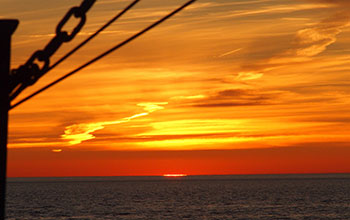Multimedia Gallery
Sunset at the deepest point in Lake Superior
Sunset at the deepest point in Lake Superior during the University-National Oceanographic Laboratory System chief scientist training cruise onboard the R/V Blue Heron.
More about this image
University of Minnesota Duluth's Andrew Barnard did his UNOLS chief scientist training onboard the R/V Blue Heron. UNOLS is a collaborative program between the National Science Foundation and the Office of Naval Research. The trip provided Barnard with the opportunity to measure background noise in Lake Michigan and Lake Superior as well as how ship noise interacts with ambient noise in deep water.
During the trip, Barnard and other researchers performed a number of tasks. Barnard used data acquisition equipment including several hydrophones (underwater microphones), microphones and accelerometers to record the ambient deep-water sounds simultaneously with sounds and vibration in the ship’s engine compartment to separate the noise from the ship with that from natural surroundings.
Barnard also deployed a conductivity-temperature-density (CTD) probe at several science stations located in lakes Michigan and Superior and collected mud (in 2-foot-deep columns) from the lake bottom at several depths. Once on deck, the cores of mud were partitioned into 1-centimeter segments and bagged for further analysis. Later, data collected from the different locations was compared in contrast to each other.
You can read a blog by Barnard about his trip Here. (Date image taken: June 2016; date originally posted to NSF Multimedia Gallery: May 31, 2017)
Credit: Dr. Andrew R. Barnard, Michigan Technological University
See other images like this on your iPhone or iPad download NSF Science Zone on the Apple App Store.
Images and other media in the National Science Foundation Multimedia Gallery are available for use in print and electronic material by NSF employees, members of the media, university staff, teachers and the general public. All media in the gallery are intended for personal, educational and nonprofit/non-commercial use only.
Images credited to the National Science Foundation, a federal agency, are in the public domain. The images were created by employees of the United States Government as part of their official duties or prepared by contractors as "works for hire" for NSF. You may freely use NSF-credited images and, at your discretion, credit NSF with a "Courtesy: National Science Foundation" notation.
Additional information about general usage can be found in Conditions.
Also Available:
Download the high-resolution JPG version of the image. (7.1 MB)
Use your mouse to right-click (Mac users may need to Ctrl-click) the link above and choose the option that will save the file or target to your computer.



